Multi-Scale Visualization Study of Water and Polymer Microsphere Flooding through Horizontal Wells in Low-Permeability Oil Reservoir
Abstract
:1. Introduction
- (1)
- Near-wellbore blocking agents: The typical near-wellbore blocking agents are fast cross-linked polymer gels. As illustrated in the article [7], the gel is generally prepared with a high concentration of low molecular weight polymers and a cross-linker. The gel can be injected in the injector or producer side, targeting the near-wellbore region (often <15 ft radial penetration) for un-fractured reservoirs. Although the agent volume is small, the resistance factor should be high enough to withstand the high-pressure drop in the near-wellbore zone. This treatment can be significantly rewarding, provided that there is no vertical cross-flow between reservoir strata.
- (2)
- In-depth blocking agents: The in-depth blocking agents are able to create a block in the deep reservoir under an activation trigger, which causes the agents to change from a “flowing” to a “blocking” state. As illustrated in the work of [8], the in-depth blocking agents are generally delayed cross-linked gels. Such conformance control agents are suitable for the condition when the high permeability streaks or fractures are well diagnosed and localized.
- (3)
- Continuous flooding agents: The continuous flooding chemical agents are injected into the reservoir in large volumes, which do not rigorously block the flowing path but increase the flow resistance. This can be achieved either by increasing the displacing phase viscosity or by the adsorption of the injectant. Therefore, the normal polymer solution is one type of continuous flooding agent that generally improves conformance control by reducing the mobility ratio [9]. The other types of continuous flooding agents include colloidal dispersion gels (CDG) [10], microgels [11], relative permeability modifiers (RPM) [12], and polymer microspheres [13].
1.1. Characteristics of USH Reservoir in D Oilfield
2. Materials and Methods
2.1. Materials
2.2. Characterization of the Polymer Microsphere Dispersion System
2.3. Macro-Coreflood Experiment
- ①
- The dry rock sample was vacuum-saturated with formation brine. The porosity was determined from the weight difference between the saturated and dry rock samples.
- ②
- The 100% water-saturated rock sample was aged for 1 week at 90 °C to reach ionic equilibrium between the rock and brine.
- ③
- Crude oil was injected into the rock sample to establish initial water saturation. Subsequently, the oil-saturated rock was aged for 3 weeks at 90 °C to restore the rock wettability.
- ④
- A total of 2.5 PV of brine was injected at a flow rate of 1.0 cc/min. Then, 1.0 PV of polymer microsphere suspension was injected at a flow rate of 1.0 cc/min. Finally, another 1 PV of chase brine was injected.
2.4. Micro-Model Experiment
3. Results and Discussion
3.1. Characterization Results of the Polymer Microsphere Dispersion System
3.2. Analysis of the Macro-Coreflood Test Results
3.3. Analysis of the Micro-Model Test Results
4. Pilot Test
5. Conclusions
- ①
- A comprehensive characterization of our used polymer microsphere was accomplished. It was revealed that the polymer microsphere has a spherical shape in the solution. The size of the polymer microsphere grew from 32.94 μm to 53.52 μm after being aged for 7 days. The apparent viscosity of the polymer microsphere dispersion also increases with time from 0.5 cP to 1.2 cP. These features indicate that the polymer microspheres are easy to inject at the wellbore with small particle size while swelling in the deep formation and function to block the preferential flowing path.
- ②
- Macro-scale visualization results indicate that due to the inverse rhythm deposition feature of the reservoir, during the waterflooding process, the water invades the upper permeable layer quickly. When polymer microspheres were injected for 1.0 PV, the oil recovery factor of both producers increased from 22.5% to 27.5%; the water cut decreased from 99.4% to 72.5%. The subsequent waterflooding even further reduced the remaining oil saturation due to the diverted water flowing path.
- ③
- Micro-scale visualization using a calcite-etched micro-mode revealed that in the waterflooding process, the displacement front displays like a “1/4 circle arc”. The sweep efficiency was improved from 86.32% to 99.15% when polymer microspheres were injected. Furthermore, the connected residual oil was reduced from 68.04% to 36.82%, accompanied by increased dispersed oil droplets and oil film.
- ④
- The pilot test with 2-injection and 3-production well pattern also proves the feasibility of conformance control by the polymer microspheres. A more than 40,000 bbls of oil increase was observed in the produces, accompanied by obvious water reduction.
Author Contributions
Funding
Data Availability Statement
Conflicts of Interest
References
- Agency, I.E. World Energy Outlook; OECD/IEA: Paris, France, 2009; ISBN 926428205X. [Google Scholar]
- Nairn, A.; Alsharhan, A. Sedimentary Basins and Petroleum Geology of the Middle East; Elsevier: Amsterdam, The Netherlands, 1997; ISBN 008054083X. [Google Scholar]
- Ebrahimi, M.; Kovacs, Z.; Schneider, M.; Mund, P.; Bolduan, P.; Czermak, P. Multistage filtration process for efficient treatment of oil-field produced water using ceramic membranes. Desalination Water Treat. 2012, 42, 17–23. [Google Scholar] [CrossRef]
- Bailey, B.; Crabtree, M.; Tyrie, J.; Elphick, J.; Kuchuk, F.; Romano, C.; Roodhart, L. Water control. Oilfield Rev. 2000, 12, 30–51. [Google Scholar]
- Elsharafi, M.O.; Bai, B. Effect of weak preformed particle gel on unswept oil zones/areas during conformance control treatments. Ind. Eng. Chem. Res. 2012, 51, 11547–11554. [Google Scholar] [CrossRef]
- Glasbergen, G.; Abu-Shiekah, I.; Balushi, S.; Wunnik, J.V. Conformance control treatments for water and chemical flooding: Material screening and design. In Proceedings of the SPE EOR Conference at Oil and Gas West Asia, Muscat, Oman, 31 March–2 April 2014. [Google Scholar]
- Sydansk, R.D.; Southwell, G. More than 12 years’ experience with a successful conformance-control polymer-gel technology. SPE Prod. Facil. 2000, 15, 270–278. [Google Scholar] [CrossRef]
- Roussennac, B.; Toschi, C. Brightwater® Trial in Salema Field (Campos Basin, Brazil). In Proceedings of the SPE Europec featured at EAGE Conference and Exhibition, Barcelona, Spain, 14–17 June 2010. [Google Scholar]
- Abu-Shiekah, I.; Glasbergen, G.; Balushi, S.; Wunnik, J.V. Conformance control treatments for water and chemical flooding: Opportunity and risk evaluation. In Proceedings of the SPE EOR Conference at Oil and Gas West Asia, Muscat, Oman, 31 March–2 April 2014. [Google Scholar]
- Bjørsvik, M.; Høiland, H.; Skauge, A. Formation of colloidal dispersion gels from aqueous polyacrylamide solutions. Colloids Surf. A Physicochem. Eng. Asp. 2008, 317, 504–511. [Google Scholar] [CrossRef]
- Dupuis, G.; Al-Maamari, R.S.; Al-Hashmi, A.; Al-Sharji, H.H.; Zaitoun, A. Mechanical and thermal stability of polyacrylamide-based microgel products for EOR. In Proceedings of the SPE International Conference on Oilfield Chemistry, The Woodlands, TX, USA, 8–10 April 2013. [Google Scholar]
- Vasquez, J.; Eoff, L.; Dalrymple, D. Laboratory Evaluation of a Relative-Permeability Modifier for Profile Modification in Injection Wells. In Proceedings of the SPE Oklahoma City Oil and Gas Symposium/Production and Operations Symposium, Oklahoma City, OH, USA, 17–19 April 2023. [Google Scholar]
- Tian, Y.; Wang, L.; Tang, Y.; Liu, C.; Ma, C.; Wang, T. Research and application of nano polymer microspheres diversion technique of deep fluid. In Proceedings of the SPE International Oilfield Nanotechnology Conference and Exhibition, Noordwijk, The Netherlands, 12–14 June 2012. [Google Scholar]
- Shiran, B.S.; Skauge, A. Wettability and oil recovery by polymer and polymer particles. In Proceedings of the SPE Asia Pacific Enhanced Oil Recovery Conference, Kuala Lumpur, Malaysia, 11–13 August 2015. [Google Scholar]
- Wang, L.; Zhang, G.; Ge, J.-J.; Li, G.; Zhang, J.; Ding, B. Preparation of microgel nanospheres and their application in EOR. In Proceedings of the SPE International Oil and Gas Conference and Exhibition in China, Beijing, China, 8–10 June 2010. [Google Scholar]
- Yao, C.; Lei, G.; Li, L.; Gao, X. Preparation and characterization of polyacrylamide nanomicrospheres and its profile control and flooding performance. J. Appl. Polym. Sci. 2013, 127, 3910–3915. [Google Scholar] [CrossRef]
- Yao, C.; Lei, G.; Li, L.; Gao, X. Selectivity of pore-scale elastic microspheres as a novel profile control and oil displacement agent. Energy Fuels 2012, 26, 5092–5101. [Google Scholar] [CrossRef]
- Goudarzi, A.; Almohsin, A.; Varavei, A.; Delshad, M.; Bai, B.; Sepehrnoori, K. New experiments and models for conformance control microgels. In Proceedings of the SPE Improved Oil Recovery Conference, Tulsa, OH, USA, 12–16 April 2014. [Google Scholar]
- Hua, Z.; Lin, M.; Dong, Z.; Li, M.; Zhang, G.; Yang, J. Study of deep profile control and oil displacement technologies with nanoscale polymer microspheres. J. Colloid Interface Sci. 2014, 424, 67–74. [Google Scholar] [CrossRef] [PubMed]
- Lenchenkov, N.S.; Slob, M.; Van Dalen, E.; Glasbergen, G.; Van Kruijsdijk, C. Oil recovery from outcrop cores with polymeric nano-spheres. In Proceedings of the SPE Improved Oil Recovery Conference, Tulsa, OH, USA, 13 April 2016. [Google Scholar]
- Andrianov, A.; Wang, Y.; Busaidi, K.; Kindi, Z.; Naabi, A.; Hasani, M.; Liu, E. Nanospheres Application for Conformance Control in Low-Permeability Carbonate Formation in Oman Block 5. In Proceedings of the Abu Dhabi International Petroleum Exhibition and Conference, Abu Dhabi, UAE, 2–5 October 2023. [Google Scholar]
- Jia, Y.; Yang, H.; Cheng, C.; Li, Z.; Hou, G.; Yuan, X.; Zhao, W.; Zhang, Z.; Liu, T. Field application and performance evaluation of polymer microsphere profile control in low permeability oil reservoir. In Proceedings of the Abu Dhabi International Petroleum Exhibition and Conference, Abu Dhabi, UAE, 14 November 2019. [Google Scholar]
- Zhao, H.; Wu, Z.; Zheng, X.; Lin, M.; Li, M. Preparation and performance research of water-soluble crosslinked polymer microspheres. Fine Chem. 2005, 22, 62–64. [Google Scholar] [CrossRef]
- Lei, G.; Zheng, J. Composing of pore-scale polymer microsphere and its application in improving oil recovery by profile control. J. China Univ. Pet. 2007, 31, 87–90. [Google Scholar]
- Liu, C.; Liao, X.; Zhang, Y.; Chang, M.-M.; Mu, C.; Li, T.; Qin, R.; Fu, R.; Bie, X.; Zheng, J. Field application of polymer microspheres flooding: A pilot test in offshore heavy oil reservoir. In Proceedings of the SPE Annual Technical Conference and Exhibition, San Antonio, TX, USA, 8–10 October 2012. [Google Scholar]
- Irvine, R.; Davidson, J.; Baker, M.; Devlin, R.; Park, H. Nano spherical polymer pilot in a mature 18 API sandstone reservoir water flood in Alberta, Canada. In Proceedings of the SPE Asia Pacific Enhanced Oil Recovery Conference, Kuala Lumpur, Malaysia, 11–13 August 2015. [Google Scholar]
- Wu, Y.-S.; Bai, B. Modeling particle gel propagation in porous media. In Proceedings of the SPE Annual Technical Conference and Exhibition, Denver, CO, USA, 21–24 September 2008. [Google Scholar]
- Feng, Q.; Zhang, G.; Yin, X.; Luan, Z. Numerical simulation of the blocking process of gelled particles in porous media with remaining polymers. Pet. Sci. 2009, 6, 284–288. [Google Scholar] [CrossRef]
- Wang, J.; Liu, H.; Wang, Z.; Xu, J.; Yuan, D. Numerical simulation of preformed particle gel flooding for enhancing oil recovery. J. Pet. Sci. Eng. 2013, 112, 248–257. [Google Scholar] [CrossRef]
- Wang, J.; Liu, H.Q.; Zhang, H.l.; Sepehrnoori, K. Simulation of deformable preformed particle gel propagation in porous media. AIChE J. 2017, 63, 4628–4641. [Google Scholar] [CrossRef]
- Bai, B.; Li, L.; Liu, Y.; Liu, H.; Wang, Z.; You, C. Preformed particle gel for conformance control: Factors affecting its properties and applications. SPE Reserv. Eval. Eng. 2007, 10, 415–422. [Google Scholar] [CrossRef]
- Bai, B.; Liu, Y.; Coste, J.-P.; Li, L. Preformed particle gel for conformance control: Transport mechanism through porous media. SPE Reserv. Eval. Eng. 2007, 10, 176–184. [Google Scholar] [CrossRef]
- Imqam, A.; Elue, H.; Muhammed, F.A.; Bai, B. Hydrochloric acid applications to improve particle gel conformance control treatment. In Proceedings of the SPE Nigeria Annual International Conference and Exhibition, Lagos, Nigeria, 5–7 August 2014. [Google Scholar]
- Wang, Z.; Bai, B.; Sun, X.; Wang, J. Effect of multiple factors on preformed particle gel placement, dehydration, and plugging performance in partially open fractures. Fuel 2019, 251, 73–81. [Google Scholar] [CrossRef]
- Pu, J.; Bai, B.; Alhuraishawy, A.; Schuman, T.; Chen, Y.; Sun, X. A recrosslinkable preformed particle gel for conformance control in heterogeneous reservoirs containing linear-flow features. SPE J. 2019, 24, 1714–1725. [Google Scholar] [CrossRef]

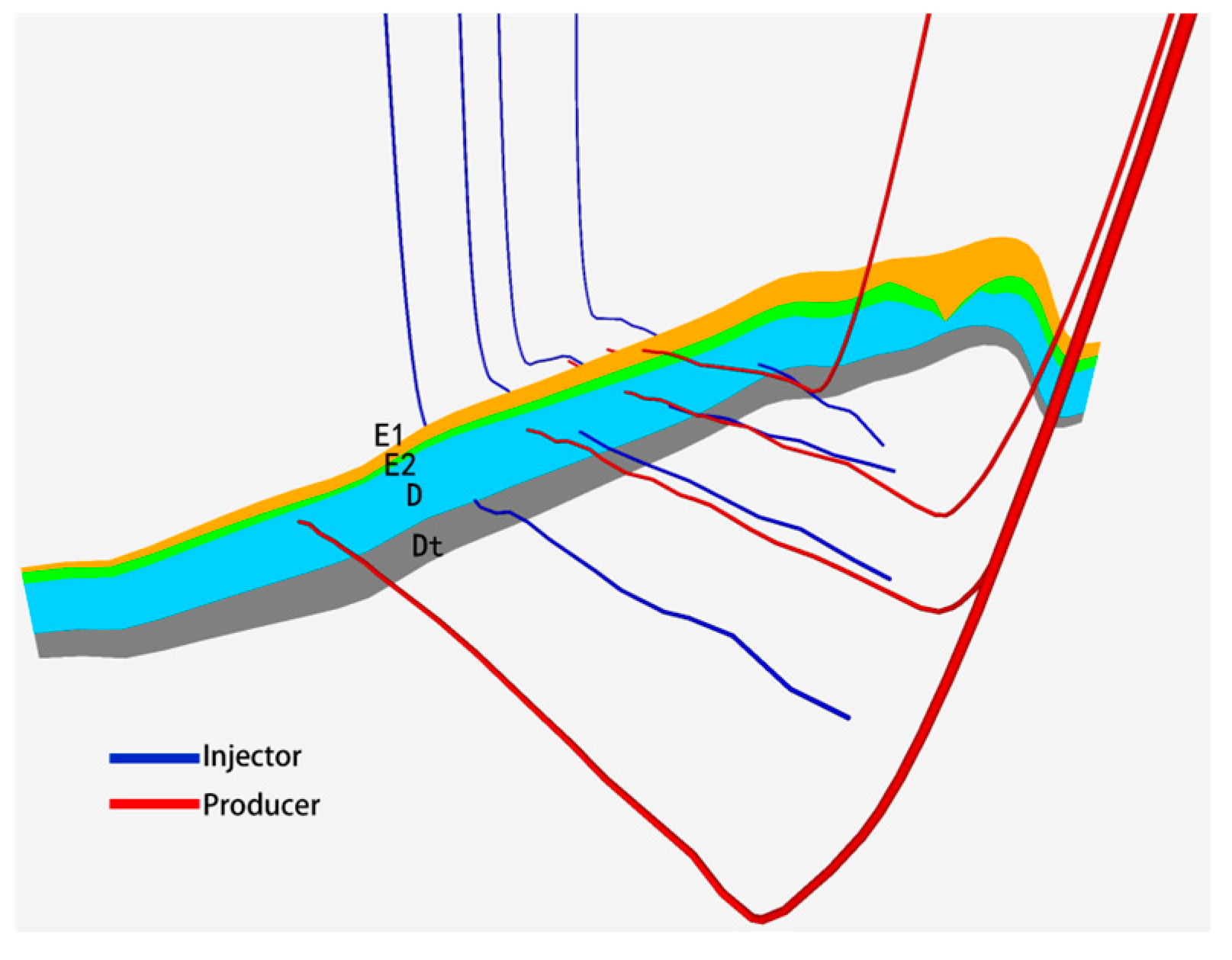
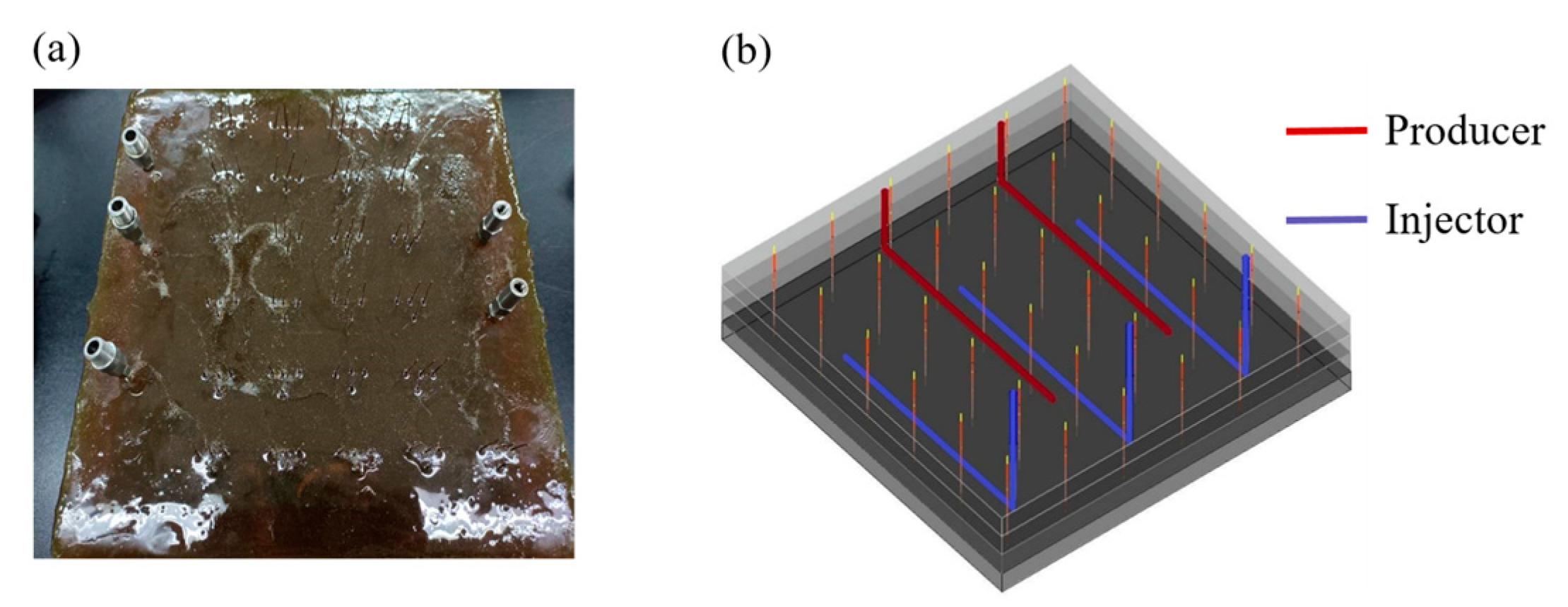

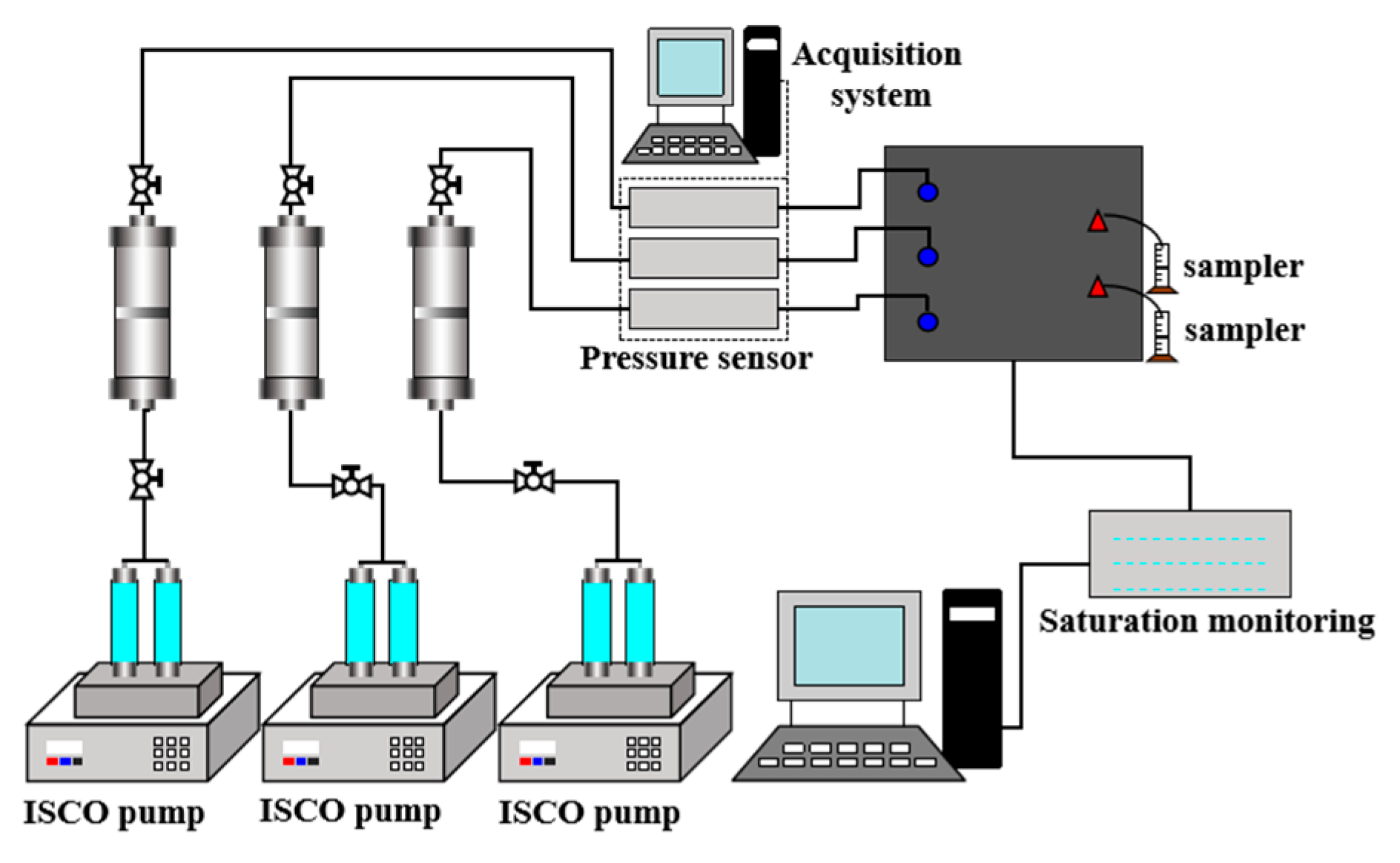
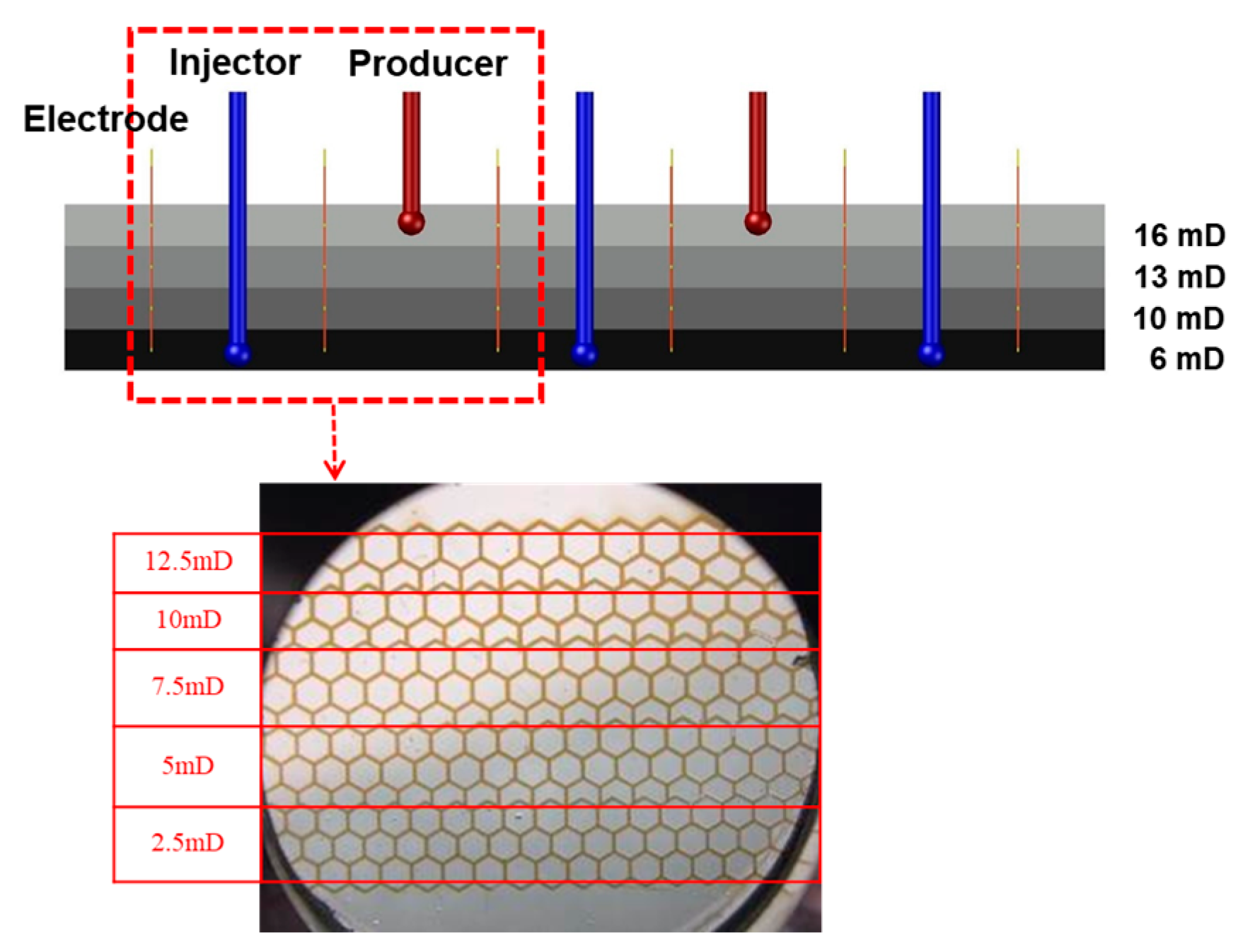
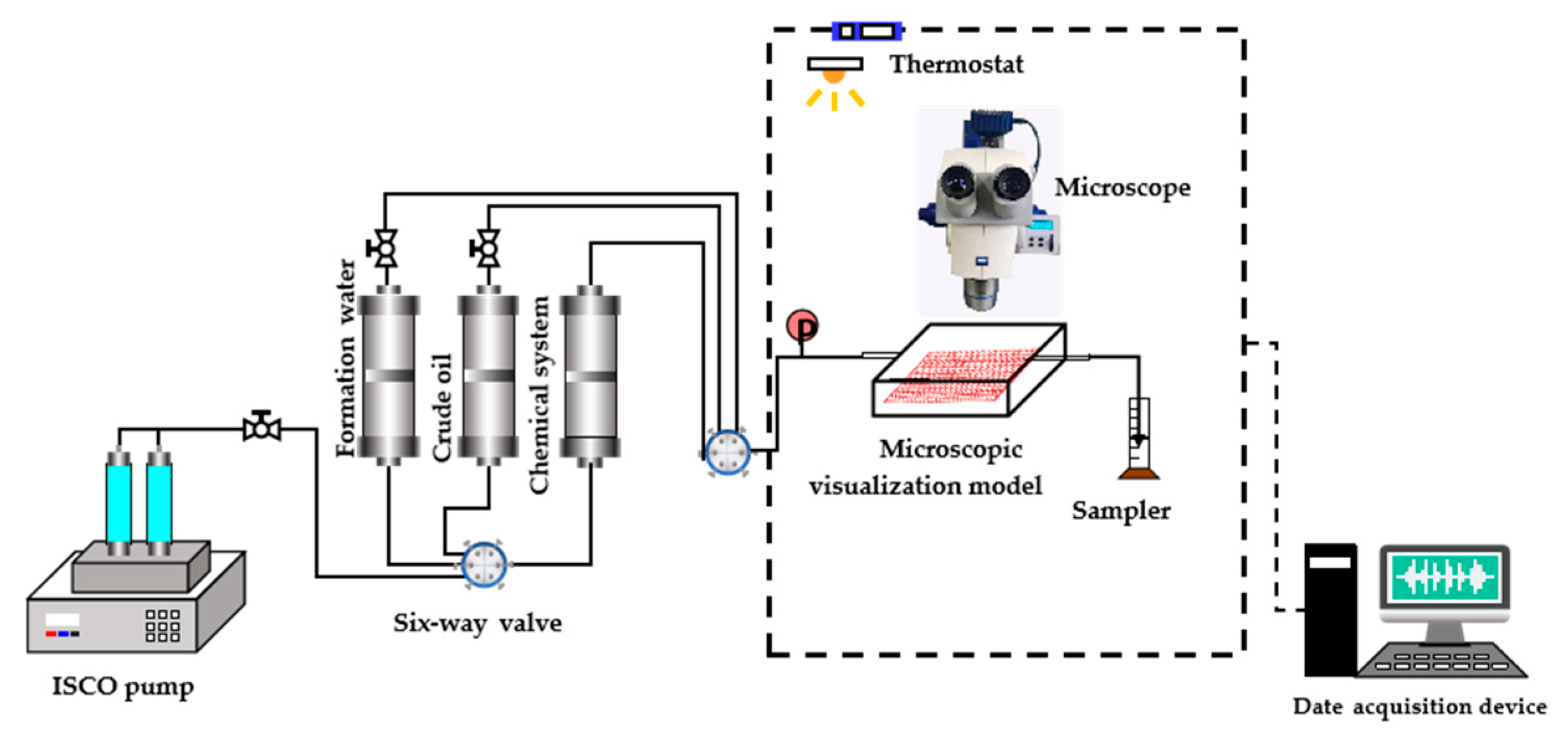
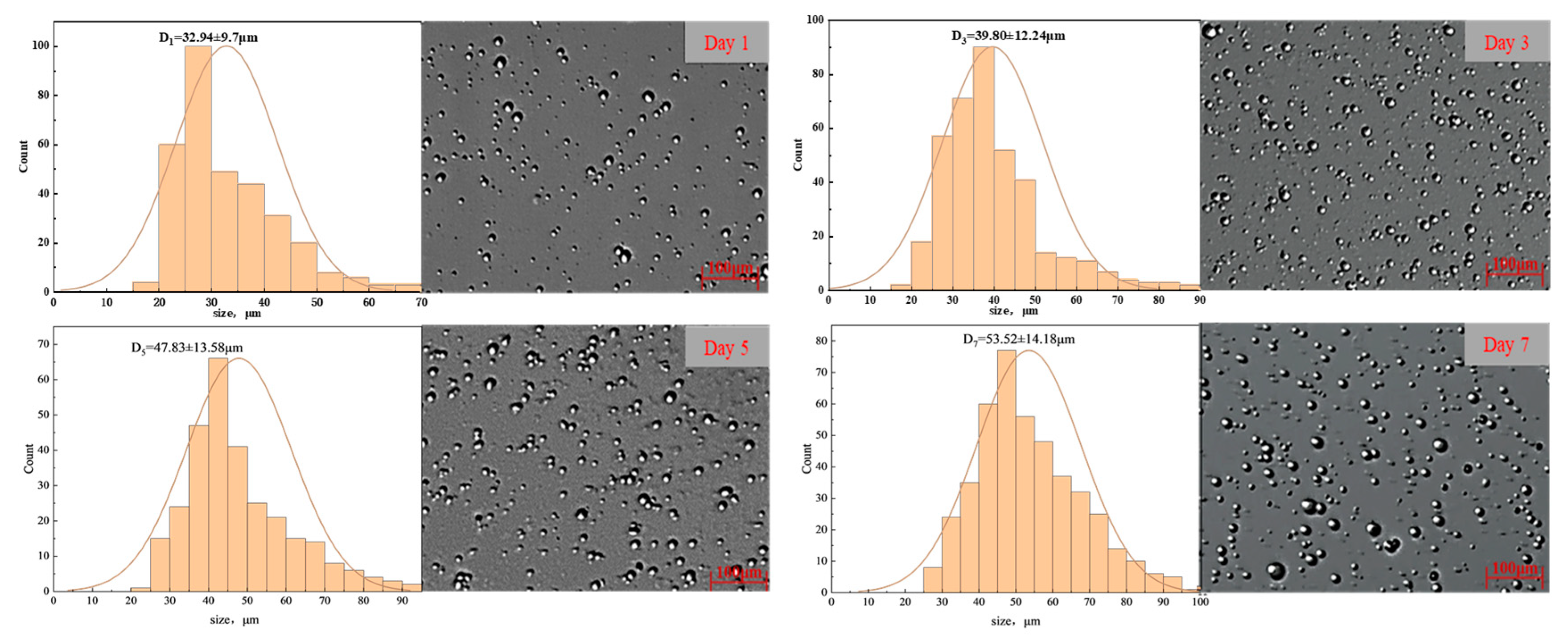
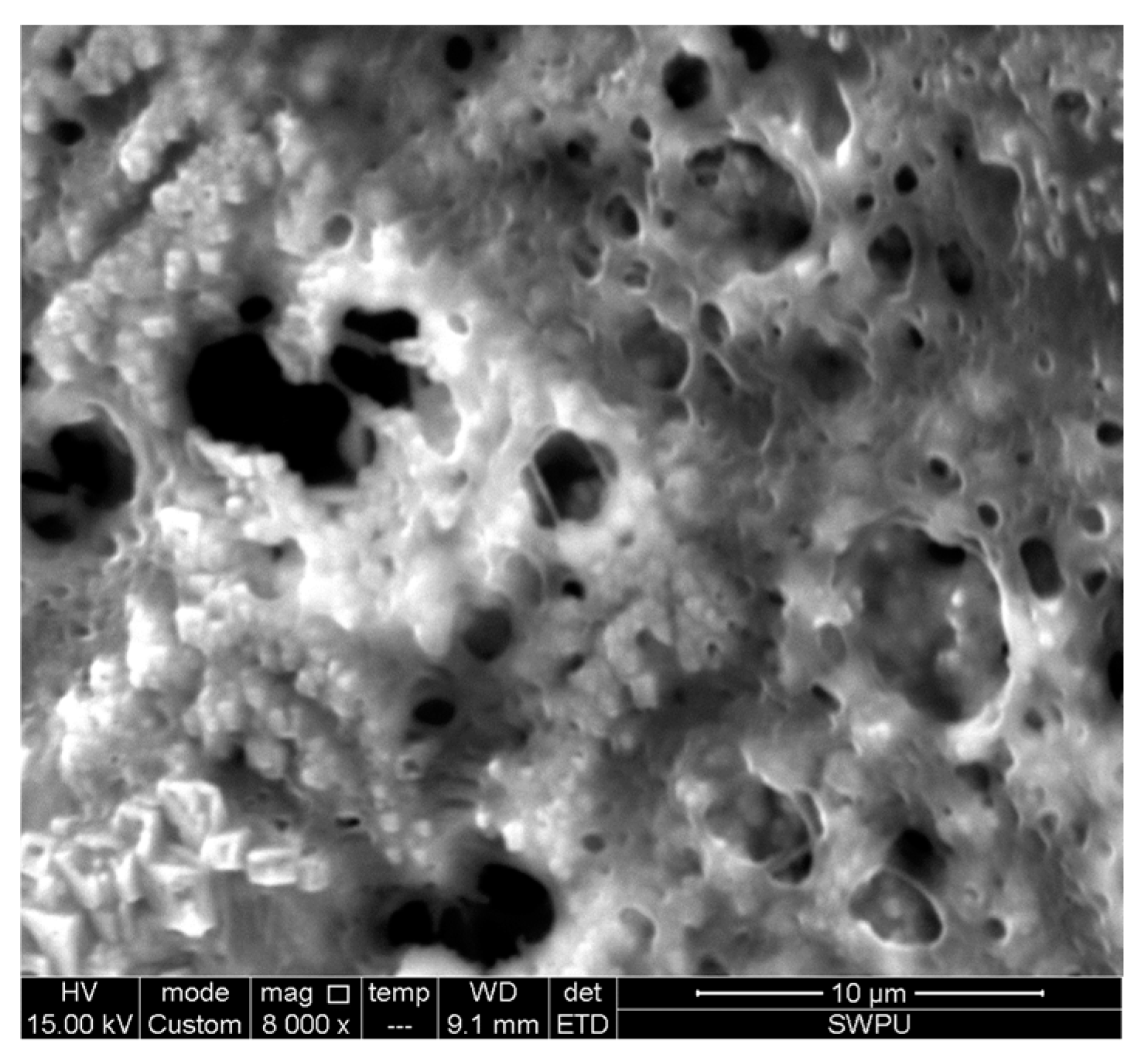
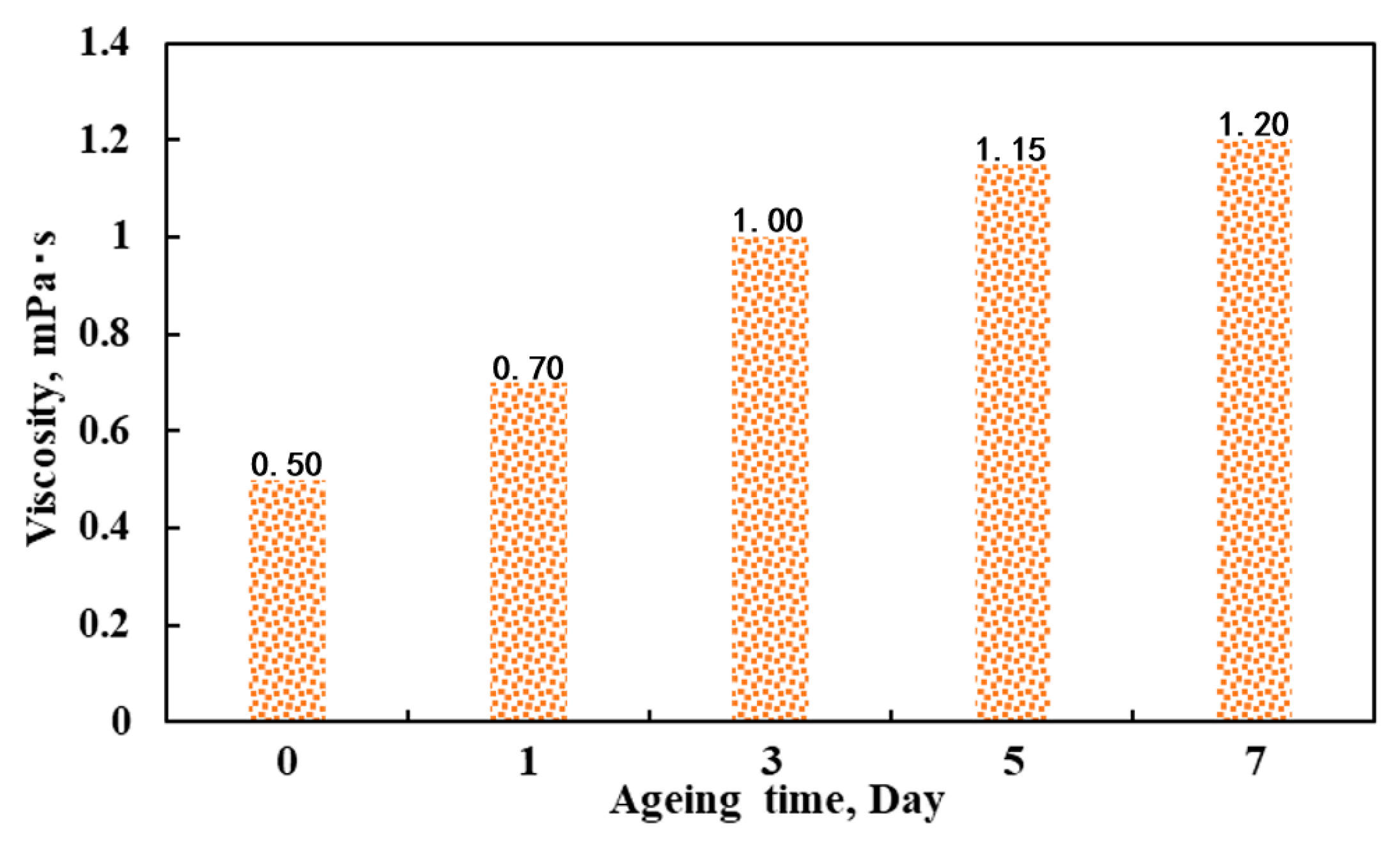



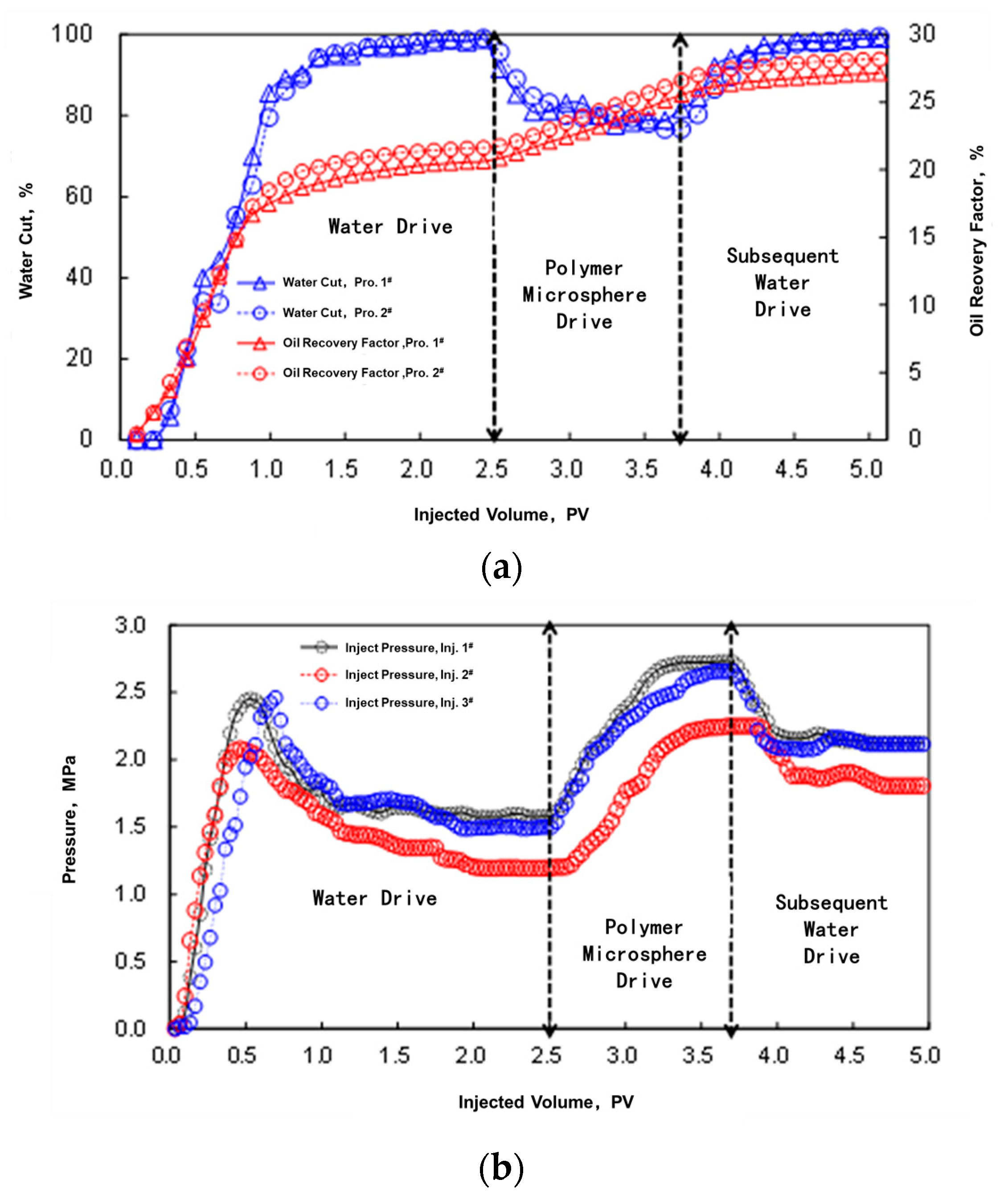

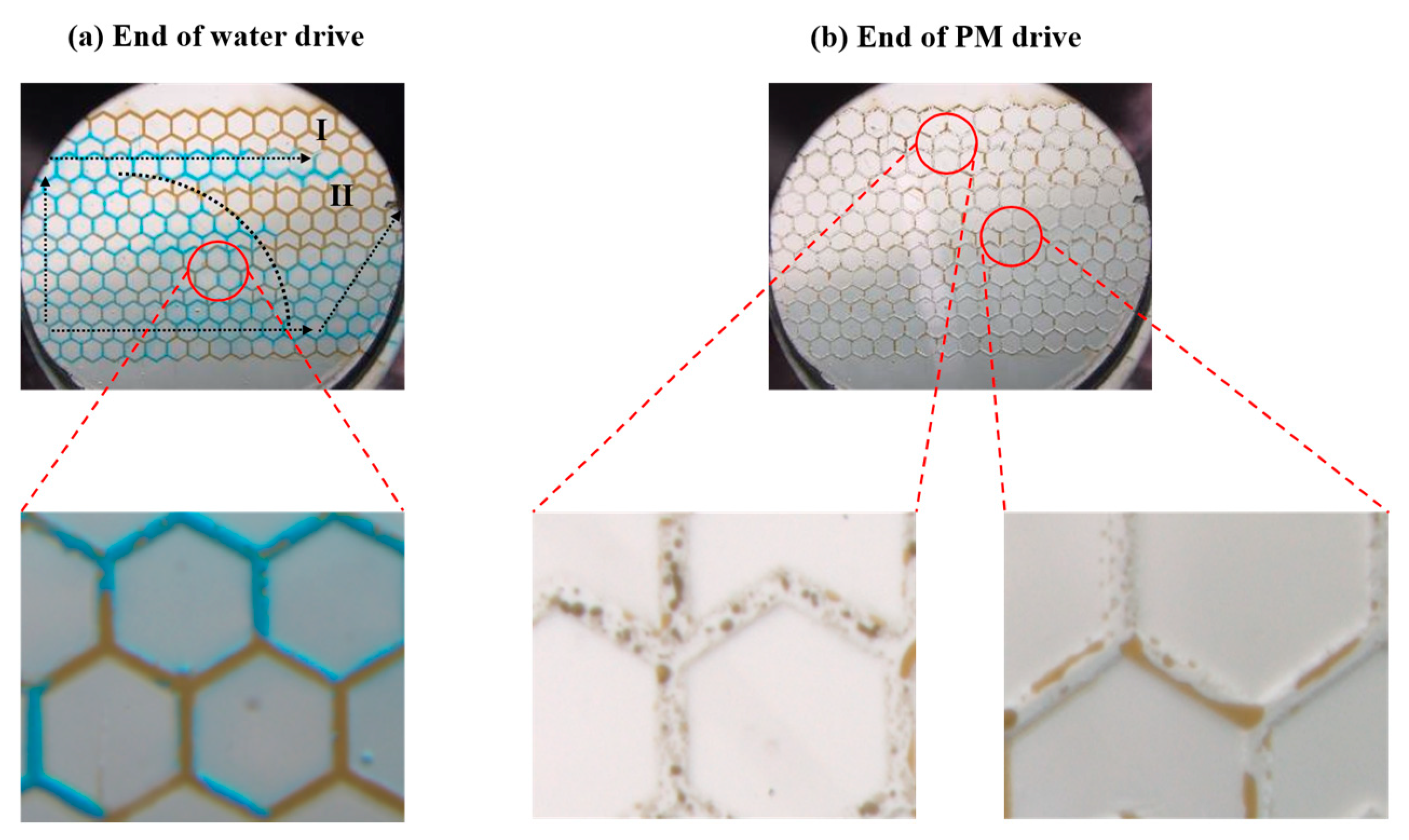
| Permeability (mD) | 12.5 | 10.0 | 7.5 | 5.0 | 2.5 |
| Pore Diameter (μm) | 2.10 | 1.64 | 0.70 | 0.82 | 0.22 |
| Displacement Stage | Sweep Efficiency/% | Connected Residual Oil/% | Residual Oil in the Form of Droplets/% | Residual Oil in the Form of Oil Film/% |
|---|---|---|---|---|
| Waterflood | 86.32 | 68.04 | 30.28 | 1.68 |
| PM drive | 99.15 | 36.82 | 50.23 | 12.95 |
| Chase water drive | 99.26 | 20.66 | 61.82 | 17.51 |
| Injector DM-02 | Injector DM-15 | ||||||||||||||||||||||||||||||||||
|---|---|---|---|---|---|---|---|---|---|---|---|---|---|---|---|---|---|---|---|---|---|---|---|---|---|---|---|---|---|---|---|---|---|---|---|
| Stage | Injection Days | Microsphere Concentration (ppm) | Injection Rate (bbl/d) | Injection Amount of Microspheres (t) | Injection Days | Microsphere Concentration (ppm) | Injection Rate (bbl/d) | Injection Amount of Microspheres (t) | |||||||||||||||||||||||||||
| Stage 1 | 31 | 2300 | 450 | 3.69 | 45 | 2000 | 950 | 10.05 | |||||||||||||||||||||||||||
| Stage 2 | 92 | 1300 | 820 | 11.94 | 145 | 1200 | 1300 | 26.74 | |||||||||||||||||||||||||||
| Stage 3 | 62 | 800 | 950 | 5.54 | 129 | 800 | 950 | 11.52 | |||||||||||||||||||||||||||
| Stage 4 | 162 | 1000 | 800 | 14.02 | 28 | 1000 | 800 | 2.5 | |||||||||||||||||||||||||||
| Total days | 347 | 347 | |||||||||||||||||||||||||||||||||
| Producer DM-01 | Producer DM-04 | Producer DM-07 | |||||||||||||||||||||||||||||||||
| Stage | Daily oil increase(bbl/d) | Daily oil increase(bbl/d) | Daily oil increase(bbl/d) | ||||||||||||||||||||||||||||||||
| Stage 1 | 5.7 | 0.0 | 0.0 | ||||||||||||||||||||||||||||||||
| Stage 2 | 34.4 | 14.4 | 0.0 | ||||||||||||||||||||||||||||||||
| Stage 3 | 16.5 | 8.0 | 0.0 | ||||||||||||||||||||||||||||||||
| Stage 4 | 65.75 | 3.3 | 18.0 | ||||||||||||||||||||||||||||||||
| Subsequent stages (376 day) | 48.8 | 2.6 | 35.2 | ||||||||||||||||||||||||||||||||
| Total oil increase (Mbbl) | 33.9 | 2.03 | 7.49 | ||||||||||||||||||||||||||||||||
| Total reduction in water cut (%) | 20.0 | 9.0 | 12.0 | ||||||||||||||||||||||||||||||||
Disclaimer/Publisher’s Note: The statements, opinions and data contained in all publications are solely those of the individual author(s) and contributor(s) and not of MDPI and/or the editor(s). MDPI and/or the editor(s) disclaim responsibility for any injury to people or property resulting from any ideas, methods, instructions or products referred to in the content. |
© 2024 by the authors. Licensee MDPI, Basel, Switzerland. This article is an open access article distributed under the terms and conditions of the Creative Commons Attribution (CC BY) license (https://creativecommons.org/licenses/by/4.0/).
Share and Cite
Cheng, L.; Xie, Y.; Chen, J.; Wang, X.; Luo, Z.; Chen, G. Multi-Scale Visualization Study of Water and Polymer Microsphere Flooding through Horizontal Wells in Low-Permeability Oil Reservoir. Energies 2024, 17, 4597. https://doi.org/10.3390/en17184597
Cheng L, Xie Y, Chen J, Wang X, Luo Z, Chen G. Multi-Scale Visualization Study of Water and Polymer Microsphere Flooding through Horizontal Wells in Low-Permeability Oil Reservoir. Energies. 2024; 17(18):4597. https://doi.org/10.3390/en17184597
Chicago/Turabian StyleCheng, Liang, Yang Xie, Jie Chen, Xiao Wang, Zhongming Luo, and Guo Chen. 2024. "Multi-Scale Visualization Study of Water and Polymer Microsphere Flooding through Horizontal Wells in Low-Permeability Oil Reservoir" Energies 17, no. 18: 4597. https://doi.org/10.3390/en17184597






